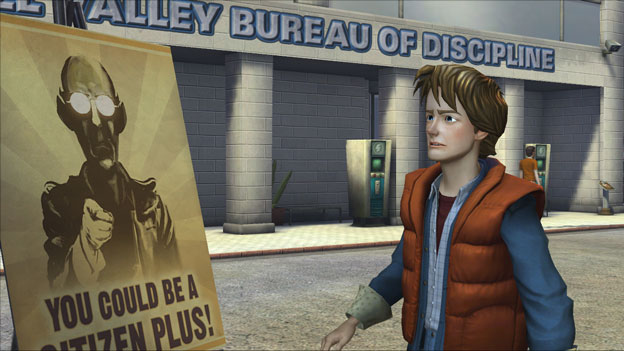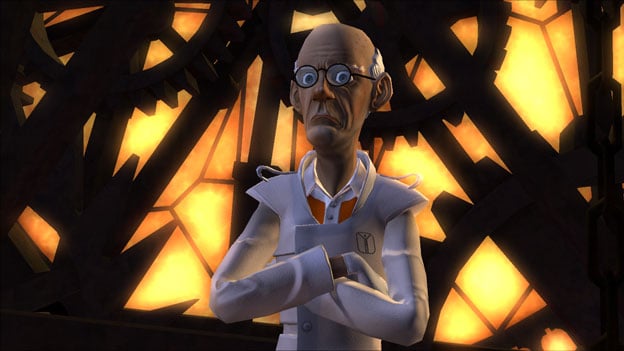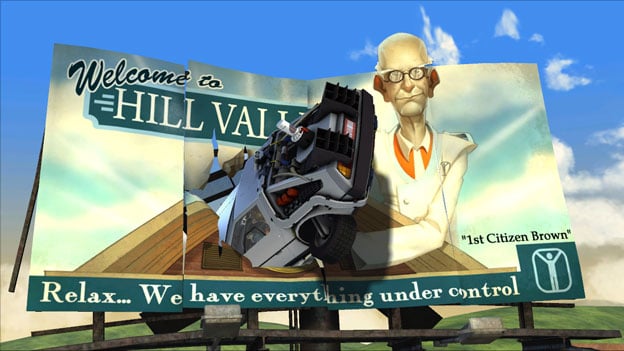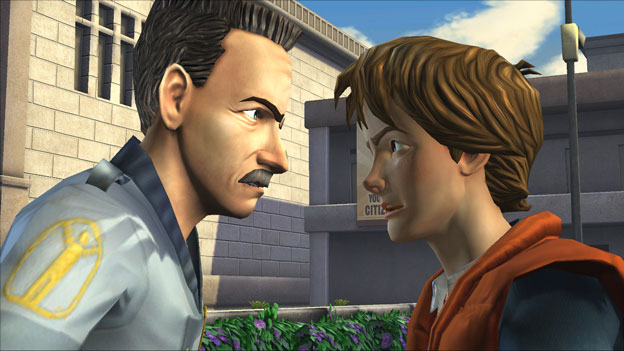Dictator Doc
The problem with meddling in the past is that no matter how you change things, they never turn out quite right. That was a main theme of the Back to the Future movie trilogy, and not surprisingly, it’s cropping up in the new game series by Telltale, too.
The main story point in Episode 3, “Citizen Brown,” revolves around Edna Strickland. In the timeline we started with back in Episode 1, the woman was harmless, and even humorous and endearing. In the 1931 scenes, she’s a newspaper reporter and the leader of the Stay Sober Society, a group that supports Prohibition. In 1986, she’s a grouchy old woman who sits at her window, screaming at neighborhood residents over minor infractions. Her younger self’s plucky, wide-eyed Puritanism, as well as her older self’s caustic hatred of anything disorderly or impure, was a source of much of the first two episodes’ humor.

However, at the end of Episode 2 (spoiler alert), Doc and Edna hit it off in 1931. As Marty and the older Doc returned to 1986, they decided not to worry about it; Doc wasn’t set to meet his future wife for a few years, so a fling with Edna shouldn’t disrupt the timeline too much, right? Unfortunately, that’s not always how romance works: When Marty arrives in 1986, Doc is nowhere to be found. It turns out that Doc married Edna, and his life took a very different course. He never even started going by “Doc”—he’s known by his real name, Emmett, or “Citizen Brown.”
Why “Citizen Brown”? Because when Doc’s genius joined forces with Edna’s authoritarian instincts, the two rose to power and took over Hill Valley. The town is an Orwellian dystopia, with Citizen Brown, Edna, and a gang of government thugs watching over everyone, handing out “demerits” for such antisocial behavior as wearing the wrong style of clothing. Marty’s father, unfortunately, works as a peeping Tom for the regime, keeping an eye on a network of cameras from the family garage. Marty’s mother is an alcoholic (as she was in the very first timeline in the Back to the Future films). Oddly enough, Marty’s mild-mannered girlfriend, Jennifer, is a rebel in this timeline, running around with dyed hair, listening to punk music, and spray-painting graffiti on the town’s walls.

To make matters worse, the DeLorean crashes into a billboard upon reentry to 1986, rendering it useless. Marty has to fix things without time travel, and the only way to do that is to meet with Citizen Brown, explain to him that his true destiny lies in time travel, and hope that this alternative version of Doc can figure out how to fix the original version’s design. To do this, however, he has to meet with Citizen Brown—the very busy leader of an oppressive regime. As Marty explores the town for a little bit, he discovers a way to get a meeting: If he gets enough demerits, he’ll be called to Brown’s office for “treatment.”
All of this amounts to an amazing plot setup, but unfortunately, it’s a setup that goes absolutely nowhere in terms of gameplay or, much worse, story. As I’ve mentioned in reviews of previous episodes, in this game, story normally takes precedent over gameplay. Point-and-click games are inherently boring to many folks, and the second episode didn’t even have good puzzles. The biggest draw is simply that it’s so much fun to finally have a new Back to the Future tale.

The main problem is that Citizen Brown has been so successful at eliminating antisocial behavior that it doesn’t take much to get his attention. Here are the three main puzzles/plot points: get caught with alcohol, kiss a girl in public (which you do by winning an asinine guitar battle with Jennifer’s new boyfriend, the way two male chimpanzees might fight for the right to a female), and violate the ban on owning dogs. After that, there’s a brief meeting with Doc before the final sequence (which I won’t spoil). These tasks aren’t very interesting in themselves, so they don’t do much for the plot, and the puzzles built around them are pretty simple, standard fare for Telltale. What’s the point?

So far as graphics go, Hill Valley looks completely different in this incarnation. That’s an improvement compared with the second episode, which took place in the exact location as the first one. The town is spotless, of course, with a strong police presence and brainwashed (but, behind closed doors, angry) civilians. The only problem is that, like the tasks you’re supposed to perform, the setting just doesn’t feel as dangerous as it should. Games about authoritarianism don’t need to be gory or even intense to make their point (think Beyond Good and Evil), but in “Citizen Brown,” you really don’t feel that intimidated when a guard questions you, or creeped out when Biff introduces you to the “Citizen Plus” program, which turned him into a polite and courteous member of society.
As for the controls and sound, they haven’t really changed since the last episodes. The controls feel a little better somehow, but they are still super-clunky, with too many invisible walls and awkward directional buttons. The music and voice acting are still great, with orchestral work that fits in with the franchise and great performances by Christopher Lloyd (who reprises his role as Doc) and A. J. LoCascio (who does a great job of imitating Michael J. Fox).
Given how much I enjoyed the first two episodes, or at least the stories in them, I’m not giving up on Back to the Future: The Game simply because this installment didn’t work out well. It could set up a great plot in Episodes 4 and 5. In fact, if you already pre-paid for the five-episode series, I’d recommend working through the episode, which takes only a few hours, simply to keep up to date on the story. But if you’re keeping tabs on the reviews until all the episodes are out, and then deciding whether to buy, count “Citizen Brown” as strike one against the game.
RATING OUT OF 5 RATING DESCRIPTION 3.7 Graphics
The same great art style, with a new location to explore. 3.7 Control
They seem to feel a little better, but they’re still clunky. 4.7 Music / Sound FX / Voice Acting
Great music and voiceover work. 2.7 Play Value
“Citizen Brown” has a great overall plot that spends too much time on bland details and bland puzzles. 3.2 Overall Rating – Fair
Not an average. See Rating legend below for a final score breakdown.
| Review Rating Legend | |||
|---|---|---|---|
| 0.1 – 1.9 = Avoid | 2.5 – 2.9 = Average | 3.5 – 3.9 = Good | 4.5 – 4.9 = Must Buy |
| 2.0 – 2.4 = Poor | 3.0 – 3.4 = Fair | 4.0 – 4.4 = Great | 5.0 = The Best |
Game Features:
